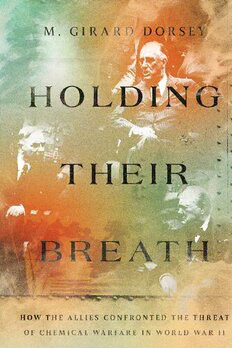
Holding Their Breath: How the Allies Confronted the Threat of Chemical Warfare in World War II PDF
Preview Holding Their Breath: How the Allies Confronted the Threat of Chemical Warfare in World War II
HOLDING THEIR BREATH A volume in the series Battlegrounds: Cornell Studies in Military History Edited by David J. Silbey Editorial Board: Petra Goedde, Wayne E. Lee, Brian McAllister Linn, and Lien- Hang T. Nguyen A list of titles in this series is available at cornellpress . cornell . edu. HOLDING THEIR BREATH HOW THE ALLIES CONFRONTED THE THREAT OF CHEMICAL WARFARE IN WORLD WAR II M. Girard Dorsey CORNELL UNIVERSITY PRESS Ithaca and London Copyright © 2023 by Cornell University All rights reserved. Except for brief quotations in a review, this book, or parts thereof, must not be reproduced in any form without permission in writing from the publisher. For information, address Cornell University Press, Sage House, 512 East State Street, Ithaca, New York 14850. Visit our website at cornellpress . cornell . edu. First published 2023 by Cornell University Press Library of Congress Cataloging- in- Publication Data Names: Dorsey, M. Girard, 1971– author. Title: Holding their breath : how the Allies confronted the threat of chemical warfare in World War II / M. Girard Dorsey. Description: Ithaca, NY : Cornell University Press, 2023. | Series: Battlegrounds: Cornell studies in military history | Includes bibliographical references and index. Identifiers: LCCN 2022023433 (print) | LCCN 2022023434 (ebook) | ISBN 9781501768361 (hardcover) | ISBN 9781501768378 (epub) | ISBN 9781501768385 (pdf) Subjects: LCSH: World War, 1939–1945— Chemical warfare. | Chemical warfare—G reat Britain— History—20th c entury. | Chemical warfare— United States— History—20th century. | Chemical warfare— Canada—History—20th century. Classification: LCC D810.C38 D67 2023 (print) | LCC D810.C38 (ebook) | DDC 940.54/85—d c23/eng/20220601 LC rec ord available at https:// lccn . loc . gov / 2022023433 LC ebook reco rd available at https:// lccn . loc . gov / 2022023434 Cover image: W. L. Mackenzie King, Franklin Delano Roosevelt, and Winston Churchill at the Second Quebec Conference, Quebec City, Canada, September 1944. Everett Collection Inc./Alamy Stock Photo. For my family, the most impor tant people in my life Contents Acknowl edgments ix Introduction: Where the Story of Chemical Warfare and World War II Began 1 1. Chain, Tool, Shield: The Role of an International Treaty in Chemical Weapons Arms Control before World War II 17 2. Is There Any Hope? Defensive Preparations against the Dreaded and Expected Gas War 41 3. The Sole Exception to the Rule: There Will Be No Chemical Conflicts, but Just in Case . . . 76 4. The Limits of Friendship: The Influence of Chemical Weapons on Alliances as World War II Expanded 110 5. Rolling the Dice: Risking Gas Warfare in Eu rope 133 6. Critical Timing: The Increasing Likelihood of Chemical Warfare in the Pacific 166 Epilogue: “I Am Fear”: Legacies of Silent Chemical Warfare 203 viii Contents Notes 211 Bibliography 269 Index 279 Acknowle dgments Although my name is listed as the author, this book is the result of material and intangible support from a variety of institu- tions and individuals. I have done my best to name them all, but I know I owe so many more than I have included h ere. Thank you. First, thank you to the libraries and archives, as well as the experts who worked there, at The National Archives in Kew; the Imperial War Museum (especially Dave McCall); the Liddell Hart Centre for Military Archives at King’s College, London; the Mass Observation Archive, University of Sussex; the Na- tional Archives and Reco rds Administration in College Park, Maryl and; the Air Force Historical Research Agency at Maxwell Air Force Base in Alabama; the Institute of World War II and the H uman Experience at Florida State Univer- sity; the Auckland War Memorial Museum; the Library and Archives Canada in Ottawa; and the University of New Hampshire Library. In par ticu l ar, Kathrine Aydelott found books upon books for me, and Linda Johnson provided not only assistance but also asked her colleagues at other institutions for help for me. I am grateful to Paul Domenet whose artwork inspired the opening to the epilogue and who permitted me to include his poster in this book. My colleagues—f aculty and staff—at the University of Hampshire (UNH), especially in the history department and the Justice Studies Program, provided encouragement and intellectual support, w hether conversing informally in the hallway, attending on-c ampus talks, or organi zing lunches where several of us could share our pro gress. I appreciate the support the University of New Hamp- shire has provided, including a Faculty Scholars leave. My deep thanks to the dean of the College of Liberal Arts at the University of New Hampshire, Mi- chele Dillon, and her pred ec ess ors and staff, for providing summer funding, ap- proving sabbaticals, and naming me the Lamberton Professor of Justice Studies with the material support that position provided. The Center for the Humanities offered not only fellowships but also an opportunity to pre sent some of my work on campus. The Hamel Center for Undergraduate Research put me in contact with a talented student who helped me find material one summer. ix
